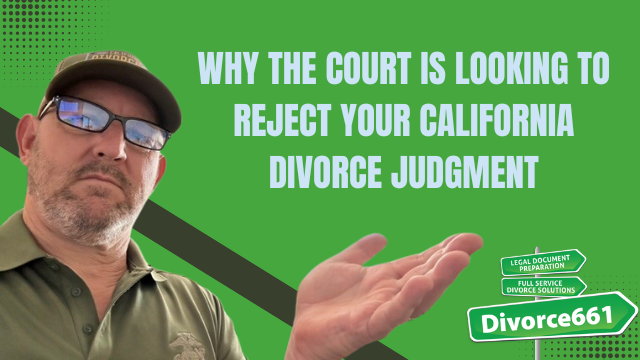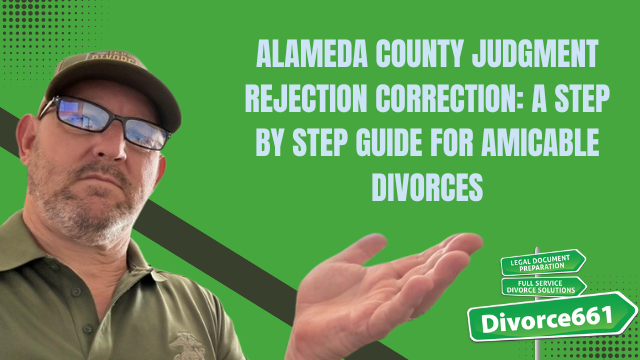What to Do If Your Divorce Papers Are Rejected in Santa Clarita?
If your divorce papers were rejected in Santa Clarita, do not panic. Rejections are common and, in most cases, are caused by small, fixable errors. Understanding why rejections happen and what to do next can save you weeks or months of delay, reduce stress, and help your case move forward quickly.
Why divorce papers get rejected
Most rejected cases come down to a few recurring issues. Identifying these makes it much easier to correct them and get your judgment approved.
- Missing attachments – Exhibits, declarations, or required attachments that must be filed with the judgment are sometimes left out.
- Incorrect forms – Using the wrong form version or failing to complete mandatory sections can trigger a rejection.
- Incomplete financial disclosures – Financial disclosures are the number one reason for rejections. Courts require accurate, complete information about income, expenses, assets, and debts.
- Poorly written agreements – Agreements that do not meet court standards or lack clarity on terms can be sent back for revision.
- Formatting or signature errors – Missing signatures, notary issues, or improper formatting are small but actionable reasons for rejection.
Common outcomes of a rejection
A rejection can cause frustrating delays. Even small errors can lead to weeks or months of additional waiting as the court requires corrected documents. The good news is that most rejections are straightforward to fix once you know what the court expects.
Real client example: fixed after two rejections
I worked with a Santa Clarita couple whose judgment was rejected twice. Their financial disclosures were incomplete and their agreement did not meet court standards. After a careful review of the entire case, we corrected the disclosures, rewrote the agreement to comply with court requirements, and resubmitted the paperwork. The court approved the judgment within days.
Most rejected cases come from small errors that are easy to fix once you know what the court needs.
What I do to get your case approved
When you bring a rejected case to me, I perform a complete review and correction service. My goal is to fix every error and refile correctly so the court approves your judgment without further delay. Here is the typical process I follow:
- Full case review – I review every document in the court file to find omissions, incorrect forms, and problematic language.
- Correct financial disclosures – I ensure income, expenses, assets, and debts are fully and accurately disclosed in the court-required format.
- Revise agreements – I rewrite agreements so they meet court standards and clearly state terms for custody, support, property division, and other issues.
- Fix formatting and signatures – I verify signatures, notarizations, and form versions to prevent technical rejections.
- Refile properly – I file the corrected judgment package with the court and follow up until the case is approved.
Practical steps to take right now if your papers were rejected
- Read the court rejection notice carefully. It will usually tell you what is missing or incorrect.
- Do not sign or file new documents until you know exactly what the court requires.
- Gather all missing attachments and supporting financial documents before you resubmit.
- Consider having an experienced reviewer check your forms and disclosures before refile.
- If you are unsure, get help to avoid repeated rejections and delays.
Tips to avoid a rejected judgment
- Complete and accurate financial disclosures are essential. Double check numbers and supporting documents.
- Use the correct form versions and fill out every required field.
- Include all exhibits and attachments the court expects.
- Write agreements in clear, court-ready language that leaves no ambiguity.
- Have a second set of experienced eyes review your packet before filing.
Why professional help can make a difference
Errors that lead to rejections often look small, but they can derail your timeline and add emotional and financial stress. Working with a team that understands the court requirements and has experience correcting rejected paperwork can get your case back on track quickly. We handle reviews, corrections, and refilings so you can move forward with confidence.
Get help and get your case back on track
If your divorce judgment was rejected in Santa Clarita, we can help. We offer a full-service solution: we fix the errors, refile correctly, and follow up until the court approves the judgment. Our services are 100 percent remote across Los Angeles County, offered at flat-fee pricing with no surprises.
Schedule a free consultation to get started. We will review your case, explain what needs to be corrected, and outline the fastest way to approval.
Visit divorce661.com for a free consultation and to get your divorce moving forward—fast and stress-free.










